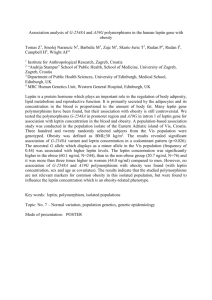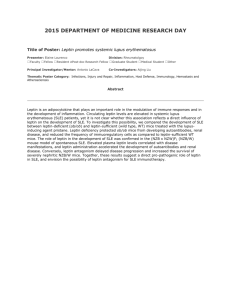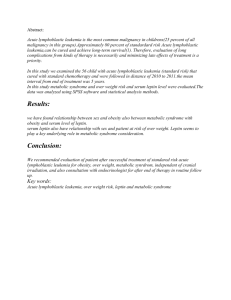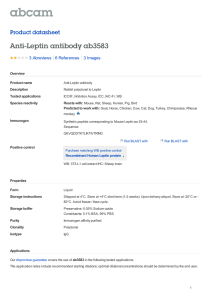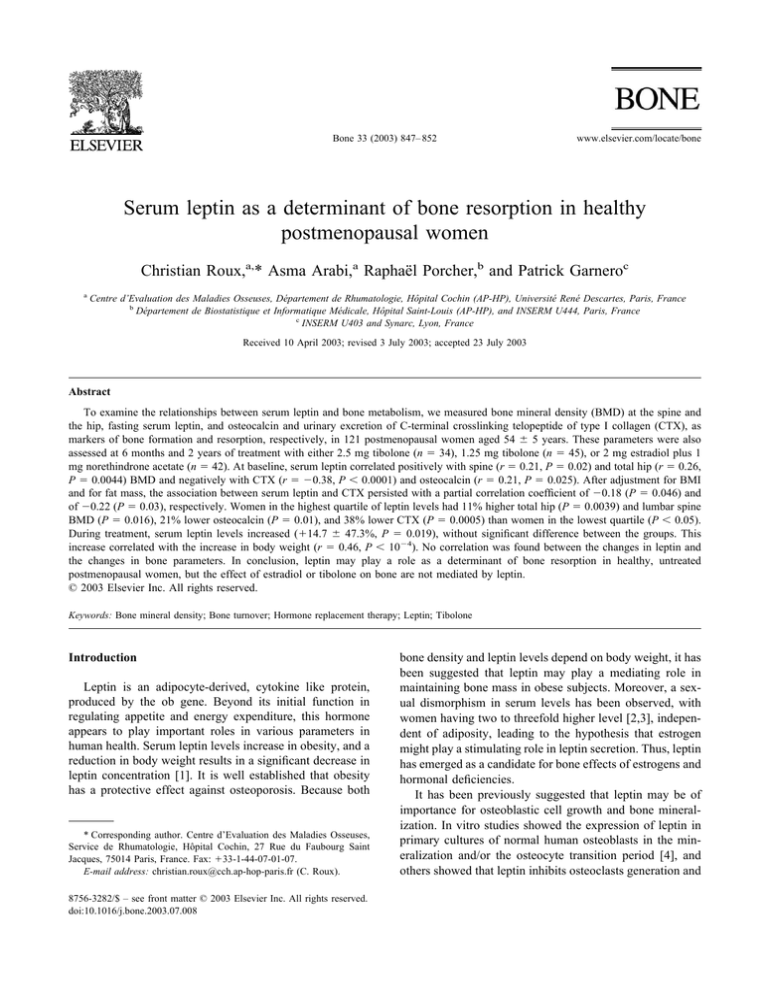
Bone 33 (2003) 847– 852
www.elsevier.com/locate/bone
Serum leptin as a determinant of bone resorption in healthy
postmenopausal women
Christian Roux,a,* Asma Arabi,a Raphaël Porcher,b and Patrick Garneroc
a
Centre d’Evaluation des Maladies Osseuses, Département de Rhumatologie, Hôpital Cochin (AP-HP), Université René Descartes, Paris, France
b
Département de Biostatistique et Informatique Médicale, Hôpital Saint-Louis (AP-HP), and INSERM U444, Paris, France
c
INSERM U403 and Synarc, Lyon, France
Received 10 April 2003; revised 3 July 2003; accepted 23 July 2003
Abstract
To examine the relationships between serum leptin and bone metabolism, we measured bone mineral density (BMD) at the spine and
the hip, fasting serum leptin, and osteocalcin and urinary excretion of C-terminal crosslinking telopeptide of type I collagen (CTX), as
markers of bone formation and resorption, respectively, in 121 postmenopausal women aged 54 ⫾ 5 years. These parameters were also
assessed at 6 months and 2 years of treatment with either 2.5 mg tibolone (n ⫽ 34), 1.25 mg tibolone (n ⫽ 45), or 2 mg estradiol plus 1
mg norethindrone acetate (n ⫽ 42). At baseline, serum leptin correlated positively with spine (r ⫽ 0.21, P ⫽ 0.02) and total hip (r ⫽ 0.26,
P ⫽ 0.0044) BMD and negatively with CTX (r ⫽ ⫺0.38, P ⬍ 0.0001) and osteocalcin (r ⫽ 0.21, P ⫽ 0.025). After adjustment for BMI
and for fat mass, the association between serum leptin and CTX persisted with a partial correlation coefficient of ⫺0.18 (P ⫽ 0.046) and
of ⫺0.22 (P ⫽ 0.03), respectively. Women in the highest quartile of leptin levels had 11% higher total hip (P ⫽ 0.0039) and lumbar spine
BMD (P ⫽ 0.016), 21% lower osteocalcin (P ⫽ 0.01), and 38% lower CTX (P ⫽ 0.0005) than women in the lowest quartile (P ⬍ 0.05).
During treatment, serum leptin levels increased (⫹14.7 ⫾ 47.3%, P ⫽ 0.019), without significant difference between the groups. This
increase correlated with the increase in body weight (r ⫽ 0.46, P ⬍ 10⫺4). No correlation was found between the changes in leptin and
the changes in bone parameters. In conclusion, leptin may play a role as a determinant of bone resorption in healthy, untreated
postmenopausal women, but the effect of estradiol or tibolone on bone are not mediated by leptin.
© 2003 Elsevier Inc. All rights reserved.
Keywords: Bone mineral density; Bone turnover; Hormone replacement therapy; Leptin; Tibolone
Introduction
Leptin is an adipocyte-derived, cytokine like protein,
produced by the ob gene. Beyond its initial function in
regulating appetite and energy expenditure, this hormone
appears to play important roles in various parameters in
human health. Serum leptin levels increase in obesity, and a
reduction in body weight results in a significant decrease in
leptin concentration [1]. It is well established that obesity
has a protective effect against osteoporosis. Because both
* Corresponding author. Centre d’Evaluation des Maladies Osseuses,
Service de Rhumatologie, Hôpital Cochin, 27 Rue du Faubourg Saint
Jacques, 75014 Paris, France. Fax: ⫹33-1-44-07-01-07.
E-mail address: christian.roux@cch.ap-hop-paris.fr (C. Roux).
8756-3282/$ – see front matter © 2003 Elsevier Inc. All rights reserved.
doi:10.1016/j.bone.2003.07.008
bone density and leptin levels depend on body weight, it has
been suggested that leptin may play a mediating role in
maintaining bone mass in obese subjects. Moreover, a sexual dismorphism in serum levels has been observed, with
women having two to threefold higher level [2,3], independent of adiposity, leading to the hypothesis that estrogen
might play a stimulating role in leptin secretion. Thus, leptin
has emerged as a candidate for bone effects of estrogens and
hormonal deficiencies.
It has been previously suggested that leptin may be of
importance for osteoblastic cell growth and bone mineralization. In vitro studies showed the expression of leptin in
primary cultures of normal human osteoblasts in the mineralization and/or the osteocyte transition period [4], and
others showed that leptin inhibits osteoclasts generation and
848
C. Roux et al. / Bone 33 (2003) 847– 852
may contribute to linkage of formation and resorption in
bone [5]. In animals, some studies showed that leptin stimulates bone growth in leptin deficient ob/ob mice [6],
whereas Ducy et al, [7] showed that these ob/ob mice have
high bone mass despite hypogonadism and hypercortisolism; intracerebroventricular infusion of leptin causes
bone loss in these mice, and leptin may regulate bone
metabolim via the sympathetic nervous system [8]. In ovariectomized rats, changes in bone metabolism are very similar
to those observed in human menopause, and administration
of leptin prevents the increase in bone turnover [9].
In humans, data are conflicting about the relationship
between bone mineral density and serum leptin [3,10,11]
and the relationship between leptin and bone metabolism
has not been clarified. The main objective of the present
study was to examine which effects the leptin exerts on
bone metabolism in humans; therefore we assessed the
relationships between serum leptin, bone mineral density,
and bone turnover markers, in healthy postmenopausal
women before any hormone replacement therapy (HRT). To
find out whether the effects of HRT on bone are mediated
by leptin, we studied the relationships between the changes
in bone parameters and the changes in leptin levels during
2-year treatment with HRT or tibolone.
Patients and methods
Subjects
This study was part of a prospective, randomised, double-blind study, comparing the effects on bone of tibolone to
those of estradiol (E2) and norethindrone acetate (NETA)
[12]. This study was conducted in two centers, using two
different randomization lists. Data presented in this study
come from one center in which blood and urine samples
were available for biological assessments. One hundred
twenty-one postmenopausal women are the basis of this
study. All participants were at least 45-years-old with intact
uterus. Criteria for entry in the study included menopause
confirmed by serum levels of estrogen ⱕ 50 pg/ml and FSH
ⱖ 20 Ul/l. Exclusion criteria were a body mass index (BMI)
below 19 or over 27 kg/m2, bilateral oophorectomy,
undiagnosed vaginal bleeding, endometrial hyperplasia, inflammatory disease, or any condition likely to require corticosteroid treatment, bone diseases, liver enzyme abnormalities, a history of cancer, or cigarette consumption ⬎ 10
cigarettes daily. Subjects were also excluded if they had
used estrogens within the last 6 months, or had calcitonin or
vitamin D treatment within the last 2 months, and drugs
known to interfere with calcium metabolism. All subjects
gave written informed consent to participate in the study
which was carried out in accordance with the Helsinki
declaration.
Treatments
Subjects received either tibolone 2.5 mg (n ⫽ 34), tibolone 1.25 mg (n ⫽ 45), or E2 2 mg plus NETA 1 mg (n ⫽
42), daily at bedtime. All women received a daily supplementation of 500 mg of calcium with a meal. Follow-up
duration was 2 years.
Assessments
Height, weight, and BMI (calculated as the weight in kg
per height in m2) were determined at baseline for each
subject. BMD (g/cm2) was measured at the left hip (the
femoral neck and the total hip), and the lumbar spine L2–L4
in the antero–posterior scan, by dual energy-X-ray absorptiometry (DEXA), using a QDR 2000 W (Hologic, MA,
USA), at baseline, 6 months, and 2 years of follow-up. For
96 patients, fat mass was measured at baseline and at 2 years
using the same device. In the whole population, at baseline,
6 months, and 2 years of follow-up, serum concentrations of
osteocalcin (using two-side radioimmunoassay, Elsa Osteo,
CisBio International, France) and the urinary excretion of
C-terminal crosslinking telopeptide of type I collagen
(CTX) corrected for creatinine, on the morning second-void
urine sample (using enzyme linked immunosorbent assay,
Crosslaps ELISA, Nordic Biosciences, Denmark) were
measured after an overnight fast. Fasting serum leptin levels
were measured using a radioimmunoassay for human leptin
(Linco Research Inc., St. Charles, MO, USA). All blood
samples were drawn between 7 and 9 AM. All assays have
an intra-and intervariability lower than 10% and were all
performed in a central laboratory with extensive experience
in biochemical marker measurements (Synarc, Lyon,
France).
Statistical analysis
Quantitative variables are expressed as median (range).
As the distributions of several -variables, and notably leptin,
CTX, or osteocalcin levels, were skewed, nonparametric
statistical methods were used for analysis. The relationships
between leptin and other variables were evaluated using
Spearman rank correlation coefficients. Because leptin is
influenced by body weight, partial rank correlation coefficients adjusted for BMI or fat mass were also computed.
Changes in leptin levels and in other parameters at 6 and 24
months were expressed as relative percent changes as compared to baseline value. Changes for the whole cohort and
within each treatment arm were tested using (one sample)
Wilcoxon signed rank sum tests. Between groups comparisons were performed using Kruskal-Wallis nonparametric
test, and no post hoc two-by-two comparisons was done as
the comparison of the three treatment was not the purpose of
this study. The associations between relative changes in
leptin and changes in other parameters were also evaluated
using Spearman rank correlation coefficients. All tests were
C. Roux et al. / Bone 33 (2003) 847– 852
849
Table 1
Baseline characteristics of the study population
Age (years)
YSM (years)
Height (cm)
Weight (kg)
BMI (kg/m2)
Total hip BMD (g/cm2)
Femoral neck BMD (g/cm2)
Spine BMD (g/c m2)
Serum leptin (ng/ml)
Serum osteocalcin (ng/ml)
Urinary CTX (g/mmol cr)
All women (n ⫽ 121)
Tibolone 2.5 mg (n ⫽ 34)
Tibolone 1.25 mg (n ⫽ 45)
E2 ⫹ NETA (n ⫽ 42)
53 (45–68)
2 (1–14)
160 (147–178)
59 (43–86)
23.0 (16.6–33.2)
0.835 (0.599–1.168)
0.708 (0.467–1.000)
0.865 (0.586–1.223)
10.7 (2.0–33.2)
25.2 (9.3–51.5)
330 (52–892)
54 (47–66)
3 (1–13)
157 (148–175)
58 (46–75)
23.3 (18.9–28.4)
0.846 (0.607–1.003)
0.710 (0.502–0.848)
0.870 (0.602–1.065)
10.7 (3.6–33.2)
25.4 (14.1–46.1)
365 (203–863)
54 (45–63)
2 (1–14)
160 (147–172)
59 (46–86)
23.1 (16.6–29.9)
0.839 (0.599–1.168)
0.703 (0.471–1.000)
0.900 (0.586–1.129)
11.1 (3.7–25.2)
25.8 (9.3–41.9)
308 (155–892)
53 (47–68)
2 (1–13)
162 (148–178)
61 (43–84)
22.1 (17.1–33.2)
0.826 (0.6–1.048)
0.708 (0.467–0.934)
0.847 (0.672–1.223)
10.1 (2.0–30.3)
24.8 (9.3–51.5)
326 (52–702)
Note. Values are median (range). YSM, time since menopause in years: BMI, body mass index: E2 ⫹ NETA, estradiol 2 mg and norethindrone acetate
1 mg.
two-sided, and at a 0.05 significance level. All analyses
were carried out using S-Plus 2000 statistical software package (MathSoft, Inc., Seattle, WA).
Results
Baseline characteristics of the patients are shown in
Table 1. There was no statistically significant difference
between groups.
Cross-sectional analyses
At baseline, leptin showed a strong positive correlation
with weight (r ⫽ 0.61, P ⬍ 10⫺4) and BMI (r ⫽ 0.73, P ⬍
10⫺4) and a weaker correlation with BMD at the spine (r ⫽
0.21, P ⫽ 0.022), total hip (r ⫽ 0.26, P ⫽ 0.0044), and
femoral neck (r ⫽ 0.18, P ⫽ 0.06). Serum leptin correlated
negatively with urinary CTX (r ⫽ ⫺0.38, P ⬍ 10⫺4), and
to a lesser degree with serum osteocalcin (r ⫽ ⫺0.21, P ⫽
0.025). However, the only association that remained significant after adjustment for BMI was between serum leptin
and urinary CTX with a partial rank correlation coefficient
of ⫺0.18 (P ⫽ 0.046). After adjustment for fat mass, the
association between serum leptin and urinary CTX was
maintained (r ⫽ ⫺0.22, P ⫽ 0.03), whereas no significant
relationship was found with BMD. No significant correlation was found between serum leptin and age (r ⫽ ⫺0.075,
P ⫽ 0.4) or time since menopause (r ⫽ 0.025, P ⫽ 0.79).
We then categorized women into quartiles of serum leptin
distribution at baseline. There was no significant difference
between quartiles of leptin in age, years since menopause,
and BMI. There was a significant, although modest association between levels of serum leptin and BMD at the spine
and total hip (Table 2), with women in the highest quartile
of leptin having on average 11% higher total hip (P ⫽
0.0039) (Fig. 1), and spine BMD (P ⫽ 0.016) than women
in the lowest quartile. On the other hand, there was an
inverse significant association between serum leptin and
bone turnover, with women in the highest quartile having on
average a 21% (P ⫽ 0.010) and 38% (P ⫽ 0.0005) lower
levels of serum osteocalcin and urinary CTX, respectively,
than women in the lowest quartile of leptin (Fig. 1). After
adjustment for BMI, these percentages were 11% (P ⫽
0.19) for serum osteocalcin and 23% (P ⫽ 0.036) for urinary CTX.
Table 2
Baseline characteristics according to quartiles of serum leptin levels
Serum leptin
Age (years)
YSM (years)
BMI (kg/m2)
Total hip BMD (g/cm2)
Femoral neck BMD(g/cm2)
Spine BMD (g/cm2)
Serum osteocalcin (ng/ml)
Urinary CTX (g/mmol cr)
First quartile (n ⫽ 31)
Second quartile (n ⫽ 31)
Third quartile (n ⫽ 29)
Fourth quartile (n ⫽ 30)
Pa
54 (45–64)
1.5 (1–14)
19.8 (16.6–25.5)
0.799 (0.599–0.977)
0.673 (0.471–0.839)
0.823 (0.586–1.017)
26.8 (16.1–47.2)
404 (106–892)
54 (47–63)
3 (1–10)
22.2 (17.4–27.5)
0.863 (0.600–1.048)
0.748 (0.467–0.934)
0.896 (0.602–1.129)
26.2 (11.3–41.0)
345 (97–737)
54 (48–66)
3 (1–13)
24.0 (21.1–26.8)
0.841 (0.607–1.093)
0.708 (0.502–0.993)
0.874 (0.626–1.129)
25.7 (15.8–42.2)
323 (140–674)
53 (45–68)
2 (1–13)
25.7 (20.4–33.2)
0.868 (0.710–1.168)
0.722 (0.592–1.000)
0.870 (0.743–1.223)
22.9 (9.3–51.5)
246 (52–566)
0.89
0.59
0.077
0.012
0.10
0.033
0.0011
⬍10⫺4
Note. Values are median (range).
a
Between groups comparison by Kruskal-Wallis test.
850
C. Roux et al. / Bone 33 (2003) 847– 852
During treatment
The percentage of changes in serum leptin levels and
other variables during follow-up are shown in Table 3. The
changes in leptin at 6 months significantly differed among
treatment groups (P ⫽ 0.0018). At 2 years, leptin increased
significantly in the whole population (mean ⫾ SD: 14.7 ⫾
47.3%, P ⫽ 0.019), without difference between treatment
groups. There was an increase in body weight (median
3.12%), which was statistically significant in each of the
three groups (P ⬍ 10⫺4), without difference among them (P
⫽ 0.71). There was a correlation between the increase in
leptin level, and the increase in body weight (r ⫽ 0.46, P ⬍
10⫺4). Women with changes in body weight above the
median had a significantly higher increase in serum leptin
than others: 30.3 ⫾ 50.5% vs ⫺0.42 ⫾ 38.7%; P ⫽ 0.0003.
The decrease in biochemical markers of remodeling and the
increase in BMD were statistically significant in all groups,
with a significant treatment effect for the majority of these
parameters (Table 3). No significant correlation was found
between changes in leptin and changes in bone parameters,
either at 6 months or at 2 years.
Discussion
Fig. 1. Mean (⫾ SEM) values of total hip BMD, serum osteocalcin, and
urinary CTX in a population of healthy postmenopausal women, according
to quartiles of serum leptin levels at baseline (from first (lowest) to fourth
(highest)). For comparison between first and fourth quartiles, P ⫽ 0.0039
for total hip BMD, P ⫽ 0.01 for serum osteocalcin, and P ⫽ 0.0005 for
urinary CTX.
In healthy nonobese, early postmenopausal women, we
found that serum leptin was a significant independent predictor of bone resorption. There was a positive correlation
between serum leptin levels and bone mineral density,
which was no longer significant after adjustment for BMI.
The effect of leptin on bone resorption was observed only at
baseline, before starting any hormonal therapy. Although
serum leptin increased during HRT and tibolone treatment,
changes in bone parameters were not related to changes in
leptin levels.
In our study, leptin levels correlated positively with
BMD at both spine and hip, and correlated strongly with
body weight and BMI. The protective effect of obesity on
bone mass is well established, and has been attributed to
several factors including the production of estrogens by
adipose tissue, weight bearing effect, and anabolic effect of
insulin on osteoblasts. However, this bone sparing effect of
obesity has not been fully explained, and because both bone
mass and leptin are related to body weight, it has been
suggested that this hormone may be a mediator regulating
this effect. The association between serum leptin levels and
bone density in women was reported in some studies
[11,13–15] and in one study in nonobese women, the positive correlation between leptin and bone mass was independent of body weight [14]. However, in agreement with
the findings of a large cross-sectional study including 1148
postmenopausal women [3], this association was not significant after adjustment for BMI or fat mass. We found a
strong inverse relationship between urinary CTX, a specific
and sensitive marker of bone resorption, and serum leptin,
C. Roux et al. / Bone 33 (2003) 847– 852
851
Table 3
Percent changes of serum leptin, bone markers, and bone mineral density after 6 months and 2 years of treatment
Tibolone (2.5 mg)
Tibolone (1.25 mg)
E2 ⫹ NETA
All women
Pa
6 months
Serum leptin
Serum osteocalcin
Urinary CTX
BMD spine
BMD total hip
⫺12.0 (⫺53.3;67.5)¶
⫺32.2 (⫺63.2;34)‡
⫺72 (⫺91.7;⫺3.1)‡
1.7 (⫺2.7;15.5)†
0.3 (⫺3.5;5.1)
⫺4.4 (⫺87.5;274.1)
⫺28.1 (⫺64.4;47.8)‡
⫺49.5 (⫺92;6.6)‡
1.1 (⫺5.1;6.2)†
0.6 (⫺2.7;5.4)
12.9 (⫺80.6;218.1)†
⫺34.6 (⫺58.8;⫺6.4)‡
⫺73.3 (⫺95.8;9.4)‡
3.7 (⫺2.5;9.8)‡
2 (⫺2.4;10.2)¶
⫺2.0 (⫺87.5;274.1)
⫺31.8 (⫺64.4;47.8)‡
⫺65.4 (⫺95.8;9.4)‡
2.2 (⫺5.1;15.5)‡
1.1 (⫺3.5;10.2)¶
0.0018
0.22
0.0001
10⫺4
0.32
2 years
Serum leptin
Serum osteocalcin
Urinary CTX
BMD spine
BMD total hip
0 (⫺56.3;102.5)‡
⫺42.7 (⫺66.8;64)‡
⫺68.3 (⫺88.5;⫺5.2)‡
3.9 (⫺2.6;9.1)‡
3.1 (⫺2.4;8.9)‡
12 (⫺57.9;175.5)‡
⫺32 (⫺61.9;19)‡
⫺47.9 (⫺91.9;66.9)†
1.2 (⫺7.1;13.7)¶
1.4 (⫺4.0;6.3)¶
11.1 (⫺58.9;144.3)‡
⫺43.6 (⫺72.9;58.7)‡
⫺65.5 (⫺94.8;28)‡
6.3 (⫺4.5;17.4)‡
3.4 (⫺4.6;12.3)‡
7.1 (⫺58.9;175.5)‡
⫺41.6 (⫺72.9;64)‡
⫺62.4 (⫺94.8;66.9)‡
3.9 (⫺7.1;17.4)‡
2.5 (⫺4.6;12.3)‡
0.13
0.022
0.0054
10⫺4
0.0014
Note. Values are median (range). Symbols indicate significant changes within group: ¶ P ⬍ 0.05; † P ⬍ 0.01; ‡ P ⬍ 10⫺4.
Between groups comparison by Kruskal-Wallis test.
a
even after adjustment for BMI or fat mass. In addition,
women with serum leptin levels in the highest quartile had
about a 38% lower levels of urinary CTX, compared with
women in the lowest quartile. Data on the relationship
between leptin and bone markers are conflicting. Some
studies did not find correlation with bone markers in women
[16,17]. Conversely, Blain et al. [15] found a borderline
relationship with bone formation markers and, in accordance with our data, a significant negative correlation with
CTX after adjustment for fat mass. The disappearance of
correlation between leptin and bone density, and the persistence of the correlation between leptin and CTX, after
adjustment for BMI and fat mass in our study, suggest that
leptin is not directly related to bone mass in women, but
may play an important role in determining bone turnover, in
healthy postmenopausal women by limiting the excessive
bone resorption related to hormonal deficiency, independently of body weight. Yamauchi et al. found that low
plasma leptin levels and not percentage fat mass was associated with the presence of vertebral fractures in postmenopausal women, suggesting that circulating leptin plays a
physiological role in maintaining better bone quality [13].
Inhibition of bone resorption by leptin has been studied
both in vivo and in vitro. Burguera et al. [9] showed that
subcutaneous administration of leptin prevents ovariectomy-induced bone loss in rats, and that combination of estrogen and leptin further decreases bone turnover compared
with that in estrogen-treated ovariectomized rats. Holloway
et al. [5] showed that leptin inhibits osteoclast generation in
culture of human peripheral blood mononuclear cells
(hPBMC) and murine spleen cells incubated in bone. These
studies have suggested that leptin modulates bone remodeling by stimulating the expression of osteoprotegerin
(OPG), the potent inhibitor of osteoclastogenesis, by stromal cells or hPBMC, and by inhibiting the expression of
RANKL, the major cytokin controlling osteoclastogenesis.
Furthermore, leptin directly induces the secretion of interleukin 1 receptor antagonist in human monocytes [18],
interleukin 1 being a key cytokin involved in bone loss
during estrogen deficiency.
Besides its effects on bone resorption, it has also been
reported that peripheral leptin administration may stimulate
bone formation in ob/ob mice [6] and that leptin acts on
human marrow stromal cells, enhancing osteoblast differentiation and inhibiting adipocyte differentiation [19]. This
inhibition of adipogenesis by leptin, the adipocytes-secreted
hormone, could be the result of a negative feedback phenomenon. However, although medullary adipocytes share
several histological and functional characteristics with
white adipocytes, it has been shown that in contrast to
extramedullary adipocytes, marrow adipocytes are unresponsive to insulin [20]. Thus, the process of adipogenesis
and the sensibility to different factors including leptin may
differ in the marrow and in the extramedullary adipose
tissues.
At baseline, leptin did not correlate with age or time
since menopause. Although in one cross-sectional study,
serum estradiol correlated negatively with leptin level in
untreated postmenopausal women, suggesting that ovarian
senescence may lead to increase in leptin secretion [21]
several previous reports showed no influence of menopause
status on serum leptin [2,22–24]. The bone loss occurring
with menopause despite the protective effect of leptin,
which does not decline, may be partly due to a resistance to
the action of leptin resulting from impaired transport to the
brain, as it has been reported in ovariectomized mice [25].
During follow-up, leptin levels increased, and these
changes correlated with changes in body weight. Although
there were higher changes in the E2⫹NETA group than in
the tibolone ones, we were not able to show a difference in
the effect of treatments on leptin (P ⫽ 0.13). Others have
shown that during long-term administration, neither HRT
[2,26 –29], nor tibolone [30] affects serum leptin concentrations. However, bone parameters changes were not related
to changes in leptin, precluding the hypothesis that leptin
may act as a mediator between HRT or tibolone and bone.
852
C. Roux et al. / Bone 33 (2003) 847– 852
Larger randomized placebo-controlled studies would be required to investigate adequately the effects of HRT and
tibolone on serum leptin.
In conclusion, the results of our study suggest that, in
healthy nonobese untreated postmenopausal women, leptin
may play an important role as a determinant of bone resorption. Effects of HRT and tibolone on bone turnover and
BMD are not explained by changes in leptin levels.
[14]
[15]
[16]
[17]
References
[1] Considine RV, Sinha MK, Heiman ML, Kriauciunas A, Stephens
TW, Nyce MR, Ohannesian JP, Marco CC, McKee LJ, Bauer TL,
Caro JF. Serum immunoreactive-leptin concentrations in normalweight and obese humans. N Engl J Med 1996;334:292–5.
[2] Castracane VD, Kraemer RR, Franken MA, Kraemer GR, Gimpel T.
Serum leptin concentration in women: effect of age, obesity, and
estrogen administration. Fertil Steril 1998;70:472–7.
[3] Ruhl CE, Everhart JE. Relationship of serum leptin concentration
with bone mineral density in the United States population. J Bone
Miner Res 2002;17:1896 –903.
[4] Reseland JE, Syversen U, Bakke I, Qvigstad G, Eide LG, Hjertner O,
Gordeladze JO, Drevon CA. Leptin is expressed in and secreted from
primary cultures of human osteoblasts and promotes bone mineralization. J Bone Miner Res 2001;16:1426 –33.
[5] Holloway WR, Collier F, Aitken CJ, Myers DE, Hodge JM, Malakellis M, Gough TJ, Collier GR, Nicholson GC. Leptin inhibits osteoclast generation. J Bone Miner Res 2002;17:200 –9.
[6] Steppan CM, Crawford DT, Chidsey-Frink KL, Ke H, Swick AG.
Leptin is a potent stimulator of bone growth in ob/ob mice. Regul
Pept 2000;92:73– 8.
[7] Ducy P, Amling M, Takeda S, Priemel M, Schilling AF, Beil FT,
Shen J, Vinson C, Rueger JM, Karsenty G. Leptin inhibits bone
formation through a hypothalamic relay: a central control of bone
mass. Cell 2000;100:197–207.
[8] Takeda S, Elefteriou F, Levasseur R, Liu X, Zhao L, Parker KL,
Armstrong D, Ducy P, Karsenty G. Leptin regulates bone formation
via the sympathetic nervous system. Cell 2002;111:305–17.
[9] Burguera B, Hofbauer LC, Thomas T, Gori F, Evans GL, Khosla S,
Riggs BL, Turner RT. Leptin reduces ovariectomy-induced bone loss
in rats. Endocrinology 2001;142:3546 –53.
[10] Thomas T, Burguera B. Is leptin the link between fat and bone mass.
J Bone Miner Res 2002;17:1563–9.
[11] Thomas T, Burguera B, Melton LJ III, Atkinson EJ, O’Fallon WM,
Riggs BL, Khosla S. Role of serum leptin, insulin, and estrogen levels
as potential mediators of the relationship between fat mass and bone
mineral density in men versus women. Bone 2001;29:114 –20.
[12] Roux C, Pelissier C, Fechtenbaum J, Loiseau-Peres S, Benhamou CL.
Randomized, double blind, 2-year comparison of tibolone with 17
estradiol and norethindrone acetate in preventing postmenopausal
bone loss. Osteoporosis Int 2002;13:241– 8.
[13] Yamauchi M, Sugimoto T, Yamaguchi T, Nakaoka D, Kanzawa
Yano S, Ozuru R, Sugishita T, Chihara K. Plasma leptin concentrations are associated with bone mineral density and the presence of
[18]
[19]
[20]
[21]
[22]
[23]
[24]
[25]
[26]
[27]
[28]
[29]
[30]
vertebral fractures in postmenopausal women. Clin Endocrinol (Oxf)
2001;55:341–7.
Pasco JA, Henry MJ, Kotowicz MA, Collier GR, Ball MJ, Ugoni
AM, Nicholson GC. Serum leptin levels are associated with bone
mass in nonobese women. J Clin Endocrinol Metab 2001;86:1884 –7.
Blain H, Vuillemin A, Guillemin F, Durant R, Hanesse B, de Talance
N, Doucet B, Jeandel C. Serum leptin level is a predictor of bone
mineral density in postmenopausal women. J Clin Endocrinol Metab
2002;87:1030 –5.
Rauch F, Blum WF, Klein K, Allolio B, Schönau E. Does leptin have
an effect on bone in adult women. Calcif Tissue Int 1998;63:453–5.
Goudling A, Taylor RW. Plasma leptin values in relation to bone
mass and density and to dynamic biochemical markers of bone
resorption and formation in postmenopausal women. Calcif Tissue Int
1998;63:456 – 8.
Gabay C, Dreyer M, Pellegrinelli N, Chicheportiche R, Meier CA.
Leptin directly induces the secretion of interleukin 1 receptor antagonist in human monocytes. J Clin Endocrinol Metab 2001;86:783–91.
Thomas T, Gori F, Khosla S, Jensen MD, Burguera B, Riggs BL.
Leptin acts on human marrow stromal cells to enhance differentiation
to osteoblasts and to inhibit differentiation to adipocytes. Endocrinology 1999;140:1630 – 8.
Maurin AC, Chavassieux PM, Frappart L, Delmas PD, Serre CM,
Meunier PJ. Influence of mature adipocytes on osteoblast proliferation in human primary cocultures. Bone 2000;26:485–9.
Gower BA, Nagy TR, Goran MI, Smith A, Kent E. Leptin in postmenopausal women: influence of hormone therapy, insulin and fat
distribution. J Clin Endocrinol Metab 2000;85:1770 –5.
Haffner SM, Mykkanen L, Stern MP. Leptin concentrations in
women in the San Antonio Heart Study: effect of menopausal status
and postmenopausal hormone replacement therapy. Am J Epidemiol
1997;146:581–5.
Hadji P, Hars O, Bock K, Sturm G, Bauer T, Emons G, Schulz KD.
The influence of menopause and body mass index on serum leptin
concentrations. Eur J Endocrino 2000;143:55– 60.
Sumner AE, Falkner B, Kushner H, Considine RV. Relationship of
leptin concentration to gender, menopause, age, diabetes, and fat
mass in African Americans. Obes Res 1998;6:128 –33.
Kastin AJ, Akerstrom V, Maness LM. Chronic loss of ovarian function decreases transport of leptin into mouse brain. Neurosci Lett
2001;310:69 –71.
Kohrt WM, Landt M, Birge SJ. Serum leptin levels are reduced in
response to exercise training but not hormone replacement therapy, in
older women. J Clin Endocrinol Metab 1996;81:3980 –5.
Hadji P, Görke K, Hars O, Bauer T, Emons G, Schulz KD. The
influence of hormone replacement therapy (HRT) on serum leptin
concentration in postmenopausal women. Maturitas 2000;37:105–11.
Laivuori H, Koistinen HA, Karonen SL, Cacciatore B, Ylikorkala O.
Comparison between 1 year oral and transdermal oestradiol and
sequential norethisterone acetate on circulating concentrations of leptin in postmenopausal women. Hum Reprod 2001;16:1632–5.
Cento RM, Proto C, Spada RS, Napolitano V, Ciampelli M, Cucinelli
F, Lanzone A. Leptin levels in menopause: effect of estrogen replacement therapy. Horm Res 1999;52:269 –73.
Panidis DK, Rousso DH, Kourtis AI, Stergiopoulos K, Mavromatidis
GA, Katsikis IK. The influence of tibolone upon serum leptin levels
in postmenopausal women. Eur J Obstet Gynecol Reprod Biol 2001;
96:85–7.

